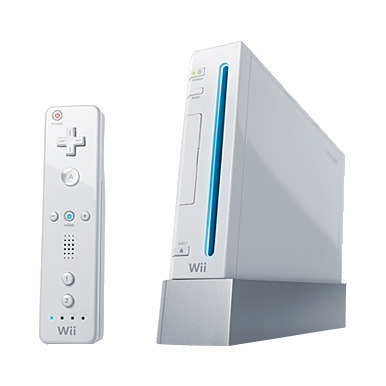Nintendo Wii Specifications
The Nintendo Wii has a very sleek and compact look. The console’s physical dimension is 8.5″ x 6″ x 2″. It has a disc drive that can support either single or dual layer optical discs and that is backward compatible with GameCube-format discs. The Wii also has average seek times that are much faster than DVD drives.
The Wii is equipped with a CMOS processor capable of 729,000 cycles per second, an ATI Hollywood GPU that works at around 243,000 Hz, 88MB RAM, 512MB flash memory, an SD card slot and an internal speaker. Furthermore, it has Bluetooth, Wi-Fi WLAN and USB LAN-connectivity.
How the Wii’s Controller Works
In previous generations of gaming consoles the controllers were very similar to one another. There are the traditional joysticks and game control buttons which have to be manipulated with both hands in order to make the characters move in the game.
The Wii’s controller is radically different. It looks like an ordinary television remote control and there is no protruding joystick anywhere. The controller itself has become the Wii’s joystick. This means that if the user needs to move the character to the right part of the screen (from the user’s perspective), the user only needs to move the controller to the right.
There is a minute material made of silicon that weighs less than 1/1,000,000 grams inside the controller. This silicon material conducts electricity to nearby silicon plates. If the controller is at rest (and therefore the silicon weight is found at the exact center of the plates), the electricity conducted to the neighboring silicon plates is the same.
The silicon weight is affixed on the controller’s chip through tiny springs which could gyrate up, down, left, right, back, and forward. If a wrist movement is made, the spring moves and the silicon material moves with it. This upsets the balance within the controller; specifically, the distance between the silicon material and the silicon plates become variable and some silicon plates become nearer to the silicon weight that others. The nearer silicon plates get higher voltages.
The change in voltage running though a particular plate becomes the basis for calculating the direction and the distance traveled by (in effect, the acceleration of) the silicon weight. The accelerometer calculates this acceleration.
After sensing the movement, the controller wirelessly sends the data to the game console. The controller’s movement is then compared to possible pre-programmed movements and translated into in-game movement.
The Advantages of the Wii User Interface
The main advantage of the Wii controller over its conventional counterparts is its ease of movement. The user need not learn any controls. He just needs to point and swing the controller to achieve the desired movement or action in the game. The controller is very precise though movements are very natural; one can virtually fish and wield a tennis racquet or a golf club. Moreover, the controller movements are translated into in-game inputs instantaneously so there’s no lag or time delay when playing.


Comments - 6 Responses to “Nintendo Wii Specifications”
Sorry but comments are closed at this time.